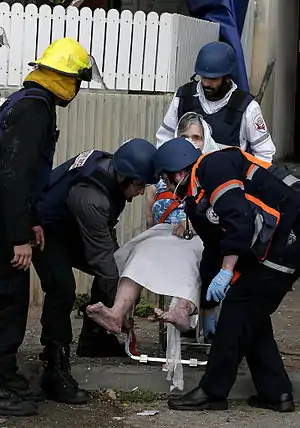Geriatric trauma
Geriatric trauma refers to a traumatic injury that occurs to an elderly person. The three prevailing causes of traumatic death in the elderly are falls (which account for 40% of traumatic death in this age group), traffic collisions and burns.[1][2]
| Geriatric trauma | |
|---|---|
 | |
| An elderly woman who was exposed to blast trauma after a rocket exploded nearby | |
| Specialty | Emergency medicine |
Biomechanics of injury
A progressive decline in central nervous system function leads to a loss of proprioception, balance and overall motor coordination, as well as a reduction in eye–hand coordination, reaction time and an unsteady gait.[2] These degenerative changes are often accompanied by osteoarthritis (degenerative joint disease), which leads to a reduction in the range of motion of the head, neck and extremities. Furthermore, elderly people frequently take multiple medications for control of various diseases and conditions. The side effects of some of these medications may either predispose to injury, or may cause a minor trauma to result in a much more severe condition. For example, a person taking warfarin (Coumadin) and/or clopidogrel (Plavix) may experience a life-threatening intracranial hemorrhage after sustaining a relatively minor closed head injury, as a result of the defect in the hemostatic mechanism caused by such medications. The combined effects of these changes greatly predisposes elderly people to traumatic injury. Both the incidence of falls and the severity of associated complications increase with advancing age.[2]
Physiologic differences in the elderly
Virtually all organ systems experience a progressive decline in function as a result of the aging process.[1][3] One example is a decline in circulatory system function caused in part by thickening of the cardiac muscle. This can lead to congestive heart failure or pulmonary edema.[4][5]
Atrophy of the brain begins to accelerate at around seventy years of age,[5] which leads to a significant reduction in brain mass. Since the skull does not decrease in size with the brain, there is significant space between the two when this occurs which puts the elderly at a higher risk of a subdural hematoma after sustaining a closed head injury.[3] The reduction of brain size can lead to issues with eyesight, cognition and hearing.[5]
Epidemiology
Elderly people are the most rapidly growing demographic in developed nations. Although they sustain traumatic injury less commonly than children and young adults, the mortality rate for trauma in the elderly is higher than in younger people.[2] In the United States, this population accounts for 14% of all traumatic injuries, of which a majority are secondary to falls.[6]
See also
References
- Grande, Christopher M.; Søreide, Eldar (2001). Prehospital trauma care. New York, N.Y: Marcel Dekker. pp. 441–50. ISBN 0-8247-0537-8.
- Committee on Trauma, American College of Surgeons (2008). "Chapter 10: Extremes of Age". ATLS: Advanced Trauma Life Support Program for Doctors (8th ed.). Chicago: American College of Surgeons. pp. 243–74. ISBN 978-1-880696-31-6.
- Campbell, John Creighton (2008). ITLS. Upper Saddle River, N.J: Pearson/Prentice Hall. pp. 279–87. ISBN 0-13-237982-1.
- Campbell, John Creighton (2000). Basic trauma life support for paramedics and other advanced providers. Upper Saddle River, New Jersey: Brady/Prentice Hall Health. pp. 231–8. ISBN 0-13-084584-1.
- Peitzman AB, Rhodes M, Schwab CW, Yealy DM, Fabian TC, eds. (2008). "Chapter 48: Geriatric Trauma". The Trauma Manual (3rd ed.). Philadelphia: Lippincott Williams & Wilkins. pp. 524–32. ISBN 0-7817-6275-8.
- Marx, John; Hockberger, Robert; Walls, Ron (August 29, 2013). Rosen's Emergency Medicine - Concepts and Clinical Practice (8th ed.). Saunders. pp. 324–9. ISBN 9781455706051.